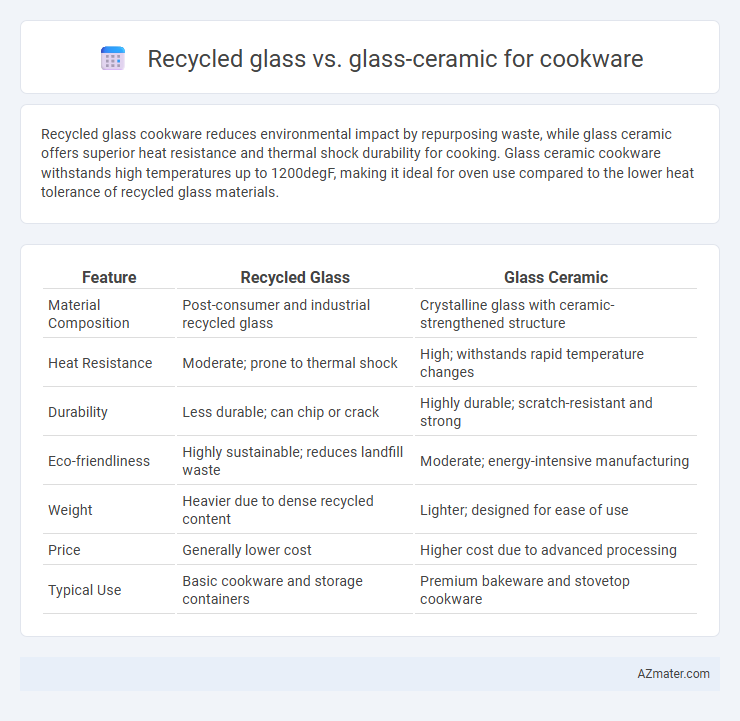Recycled glass cookware reduces environmental impact by repurposing waste, while glass ceramic offers superior heat resistance and thermal shock durability for cooking. Glass ceramic cookware withstands high temperatures up to 1200degF, making it ideal for oven use compared to the lower heat tolerance of recycled glass materials.
Table of Comparison
| Feature | Recycled Glass | Glass Ceramic |
|---|---|---|
| Material Composition | Post-consumer and industrial recycled glass | Crystalline glass with ceramic-strengthened structure |
| Heat Resistance | Moderate; prone to thermal shock | High; withstands rapid temperature changes |
| Durability | Less durable; can chip or crack | Highly durable; scratch-resistant and strong |
| Eco-friendliness | Highly sustainable; reduces landfill waste | Moderate; energy-intensive manufacturing |
| Weight | Heavier due to dense recycled content | Lighter; designed for ease of use |
| Price | Generally lower cost | Higher cost due to advanced processing |
| Typical Use | Basic cookware and storage containers | Premium bakeware and stovetop cookware |
Introduction to Sustainable Cookware Materials
Recycled glass and glass ceramic are pivotal materials in sustainable cookware innovation, offering eco-friendly alternatives to traditional options. Recycled glass reduces landfill waste and energy consumption through repurposing glass bottles and containers, while glass ceramics provide durability and thermal resistance with low environmental impact due to their long lifespan. These materials contribute significantly to reducing carbon footprints in kitchenware production and promote sustainable consumption in modern households.
What is Recycled Glass Cookware?
Recycled glass cookware is made by melting down discarded glass materials and reshaping them into durable, heat-resistant kitchenware, offering an eco-friendly alternative to traditional cookware. This process reduces landfill waste and conserves raw materials while maintaining the essential properties needed for cooking, such as thermal stability and non-toxicity. Unlike glass ceramic, which is specifically engineered for heat resistance through controlled crystallization, recycled glass cookware emphasizes sustainable production without compromising functionality.
Understanding Glass Ceramic Cookware
Glass ceramic cookware offers superior thermal resistance and durability compared to recycled glass, making it ideal for high-temperature cooking and rapid temperature changes. It features a non-porous surface that resists staining and odors, ensuring long-lasting hygiene and easy maintenance. Engineered with precise thermal properties, glass ceramic cookware provides even heat distribution, enhancing cooking performance and energy efficiency.
Manufacturing Processes: Recycled Glass vs Glass Ceramic
Recycled glass cookware is manufactured by melting post-consumer glass waste, which reduces energy consumption by about 30% compared to raw material production, promoting sustainability. Glass ceramic cookware undergoes a more complex process involving controlled nucleation and crystallization, resulting in enhanced thermal shock resistance and durability. The manufacturing of glass ceramics requires higher temperatures and longer processing times, increasing production costs but delivering superior performance for heat distribution and retention.
Thermal Resistance and Performance Comparison
Recycled glass cookware offers moderate thermal resistance but is generally less durable under rapid temperature changes compared to glass ceramic, which excels in thermal shock resistance due to its engineered crystalline structure. Glass ceramic cookware withstands high heat and sudden cooling, making it ideal for stovetop use and oven-to-table applications, while recycled glass is better suited for low to moderate temperature cooking. Performance-wise, glass ceramic ensures even heat distribution and longevity, whereas recycled glass cookware may be more prone to cracking and less efficient in thermal conductivity.
Durability and Lifespan of Each Material
Recycled glass cookware offers moderate durability but may be prone to chipping or cracking under extreme temperature changes, with a typical lifespan of 3-5 years. Glass ceramic cookware is highly durable and resistant to thermal shock, often lasting 10 years or more with proper care. The superior heat resistance and toughness of glass ceramic make it a preferred choice for long-term cookware use.
Safety and Health Considerations
Recycled glass cookware offers a non-toxic, lead-free option that resists chemical leaching, making it safer for health-conscious users. Glass ceramic cookware provides excellent thermal shock resistance and remains stable at high temperatures, reducing risks of cracking or releasing harmful substances during cooking. Both materials are BPA-free and reduce exposure to hazardous chemicals compared to some metal or non-stick alternatives, ensuring safer cooking experiences.
Environmental Impact: Which is Greener?
Recycled glass cookware significantly reduces landfill waste and lowers energy consumption compared to virgin glass production, making it a more sustainable option. Glass ceramic, while durable and energy-efficient during cooking, involves higher energy use and raw material extraction in manufacturing. Choosing recycled glass cookware supports circular economy principles and decreases carbon footprint, positioning it as the greener choice environmentally.
Cost Comparison: Affordability and Value
Recycled glass cookware generally offers greater affordability compared to glass ceramic, making it an attractive option for budget-conscious consumers. While glass ceramic boasts superior durability and heat resistance, its higher manufacturing costs translate into elevated retail prices. Evaluating long-term value involves balancing initial cost savings of recycled glass against the longevity and performance benefits provided by glass ceramic cookware.
Choosing the Right Material for Your Cooking Needs
Recycled glass cookware offers eco-friendly benefits and excellent thermal resistance, making it ideal for everyday baking and slow cooking. Glass ceramic cookware provides superior heat distribution and durability, excelling in stovetop and high-temperature applications. Assess your cooking style, heat requirements, and environmental considerations to choose between the sustainable choice of recycled glass and the high-performance glass ceramic.

Infographic: Recycled glass vs Glass ceramic for Cookware
 azmater.com
azmater.com